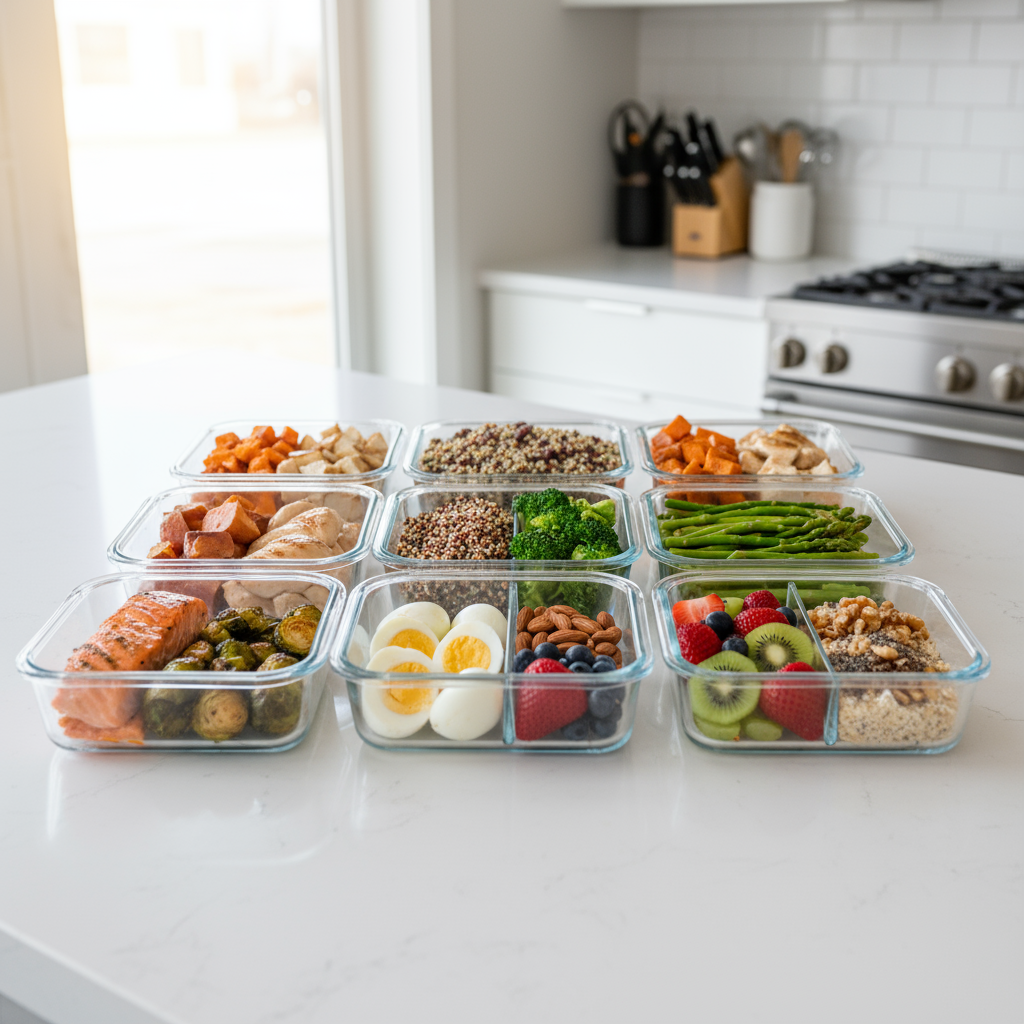
Table of Contents
Introduction
Here’s the truth about diets: most of them are terrible. You’ve probably been there—trying every new fad that promises you’ll drop pounds fast, only to end up hungry, cranky, and right back where you started. Sound familiar? The real game-changer isn’t another restrictive diet. It’s building healthy meal plans that actually work with your life, not against it. Think of it as creating a roadmap for your taste buds and your health goals—one that leads to lasting weight loss without making you miserable.
Let’s get real about why meal planning matters so much. When you have a plan, you’re not making food decisions when you’re starving at 6 PM (we all know how that goes). Instead, you’re setting yourself up with nutrient-packed meals that keep your metabolism humming and your hunger in check. Most people struggle with weight loss because they’re winging it—grabbing whatever’s convenient, eating at random times, making it up as they go. But here’s what changes everything: a structured approach that doesn’t feel like punishment. Want to dive deeper into the bigger picture? Check out these balanced diet benefits that’ll show you how meal planning fits into your overall wellness strategy.
Now, here’s where it gets interesting. Good meal planning isn’t just about the number on the scale—though that’s definitely part of it. When you’re eating balanced meals loaded with protein, healthy fats, and complex carbs, something amazing happens. Your energy stops crashing at 3 PM. Your brain fog lifts. You actually feel satisfied after eating instead of hunting around the kitchen an hour later. (And let’s be honest, who doesn’t want that?) The mental side is huge too—when you’re not stressed about what to eat or beating yourself up over food choices, everything else gets easier. Curious about how what you eat affects how you think? The connection between nutrition and mental health is pretty mind-blowing.
So what does a smart meal plan actually look like? It starts with understanding the basics—and don’t worry, this isn’t rocket science. You want lean proteins that keep you full, fiber-rich vegetables that give your body what it needs, and whole grains that provide steady energy. The key is avoiding the processed stuff that’s designed to make you want more. Think of whole foods as your allies and processed foods as that friend who always gets you into trouble. If you want to get really good at this, learning about portion control for weight loss will teach you how much to eat and when—no measuring cups required once you get the hang of it.
Weight loss isn’t just about food, though. (I know, I know—if only it were that simple.) Staying hydrated is like giving your metabolism a daily tune-up. When you’re properly hydrated, your body burns calories more efficiently and you’re less likely to mistake thirst for hunger. Add some regular movement to the mix, and you’re not just losing weight—you’re building a stronger, healthier you. Speaking of movement, the benefits of regular physical activity go way beyond burning calories, and they pair perfectly with smart eating habits.
What You’ll Learn in This Guide
Ready to transform how you think about food and weight loss? This guide will walk you through everything step by step. No confusing jargon, no impossible standards—just practical, doable strategies that fit into real life.
- Understanding the Importance of Healthy Meal Plans: We’ll explore why having a solid meal plan is your secret weapon for sustainable weight loss and how it improves way more than just what you see in the mirror.
- Key Nutritional Components: You’ll discover which nutrients your body actually needs to thrive, and why ditching processed foods isn’t about being perfect—it’s about feeling amazing.
- Sample Meal Plans and Recipes: Get ready for meal ideas that’ll make you excited about eating healthy—breakfasts that energize you, lunches that satisfy you, dinners that don’t require a culinary degree, and snacks that actually taste good.
- Effective Meal Prepping and Planning Strategies: Learn the time-saving tricks that make healthy eating effortless, from smart grocery shopping to batch cooking techniques that’ll save your weeknight sanity.
By the time you finish this guide, you’ll have everything you need to create meal plans that work for your schedule, your taste preferences, and your goals. No more guessing, no more starting over every Monday. Just sustainable strategies that make sense. And if you’re the type who loves a good app to keep you motivated, these weight loss and fitness apps can be your digital support team, helping you track progress and stay on course.
As we go through each section, you’ll learn how to spot the foods that fuel your body versus the ones that work against you. You’ll master the art of creating balanced meals that keep your metabolism firing on all cylinders. Most importantly, you’ll discover how to avoid the common pitfalls that trip up so many people (hint: it’s usually about being too restrictive or too vague). The mental benefits alone—better mood, less food stress, more confidence—make this journey worth it.
Before we jump into the nuts and bolts of meal planning, let’s talk foundation. Understanding how protein, fats, and carbs work together is like learning the rules of the game before you start playing. Add proper hydration to the mix, and you’ll have the confidence to make smart choices whether you’re meal prepping on Sunday or deciding what to order at lunch. With the right knowledge and practical tools, you’ll design meal plans that satisfy your cravings while supporting your health goals. This isn’t about perfect eating—it’s about sustainable changes that lead to lasting results and a healthier, happier you.

Now that we’ve covered why healthy meal planning matters, let’s get into the real meat of it—what actually makes a meal plan work for weight loss. We’re going to break down the essential building blocks, then show you some practical meal plans you can actually use (no complicated recipes or ingredients you’ve never heard of, promise). Here’s the thing: losing weight isn’t just about eating less. It’s about eating smart. You need the right balance of nutrients to keep your energy up, your mood stable, and your metabolism humming along. The sample meal plans we’ll share aren’t just theoretical—they’re designed to boost fat loss while keeping you satisfied and energized throughout the day.
Key Components of a Healthy Meal Plan for Weight Loss
Building a meal plan that actually works? It comes down to focusing on nutrient-dense foods, getting your macronutrients balanced, staying hydrated, and—this is crucial—avoiding the processed stuff that sabotages your progress. Think of it this way: proteins, healthy fats, and complex carbs are like a well-oiled team. Proteins keep your muscles strong and help you feel full longer. Healthy fats keep your hormones happy and your brain sharp. Complex carbs give you steady energy without those blood sugar rollercoaster rides that leave you crashing and craving junk. If you want to nail this balance, check out portion control for weight loss—it breaks down the practical side of getting your portions right.
Here’s something people often overlook: water. Seriously, staying hydrated isn’t just about avoiding headaches—it actually fires up your metabolism and helps control your appetite. But it’s not just about chugging H2O. You need those vitamins and minerals from real food too, because when you’re deficient, your body basically hits the brakes on weight loss. And those energy levels? They tank. The processed food trap is real, folks. Those convenience foods packed with sugar, unhealthy fats, and empty calories make losing weight feel impossible. Stick with whole foods that haven’t been messed with too much, and you’ll notice the difference—not just in how you look, but in how you feel and think. Speaking of feeling good, there’s a fascinating connection between what you eat and your mental clarity. Dive into the benefits of a balanced diet to see how proper nutrition can transform more than just your waistline.
Key Aspects of a Healthy Meal Plan
Getting these fundamentals right means you can create an approach that actually fits your life, your tastes, and your specific goals.
- Macronutrient Balance: This is where the magic happens—getting proteins, fats, and carbs working together instead of against each other. Proteins keep your muscles intact and make you feel satisfied. Fats support hormone production (yes, you need them for weight loss). Complex carbs provide steady fuel without the crash. Want to level up your carb game? Learn about whole grain benefits to make smarter choices that keep you full and energized.
- Micronutrients and Hydration: Those vitamins and minerals from colorful fruits and vegetables? They’re the unsung heroes keeping your metabolism running smoothly. And proper hydration does double duty—it revs up your metabolic rate and helps control those “am I hungry or just bored?” moments. For more insights on keeping everything in balance, how to maintain a balanced diet has some solid advice.
- Avoiding Processed Foods: This one’s tough because processed foods are everywhere and they’re designed to be irresistible. But those refined sugars and artificial additives? They’re working against you, causing energy crashes and making it harder to stick to your goals. Whole foods might seem boring at first, but they’re your ticket to sustained energy and real fat loss.
- Portion Control: Here’s where many people stumble—even healthy food can derail your progress if you’re eating too much of it. Learning to eyeball proper portions (or actually measuring until it becomes second nature) helps you maintain that calorie deficit without feeling deprived.
Now that you understand the foundation, let’s move on to the fun part—actual meal plans you can use starting today. The next section gives you real meal ideas that put all these principles into practice, so you can see what balanced, satisfying eating looks like in the real world. No more guessing what to eat or wondering if you’re doing it right.
Sample Healthy Meal Plans for Weight Loss
Alright, let’s get practical. Creating meal plans that actually work means designing them to hit three targets: proper nutrition, calorie control, and—this is important—meals you’ll actually enjoy eating. Take breakfast, for example. Start your day with protein and fiber, and you’ll kickstart your metabolism while keeping those mid-morning snack attacks at bay. We’re talking about real meal ideas here—lean proteins, fresh vegetables, and whole grains that give you energy and satisfaction. Need more inspiration? Check out best healthy food recipes for ideas that align perfectly with your weight loss goals.
When it comes to lunch and dinner, think of your plate as having three sections: lean protein (chicken, fish, or plant-based options), colorful vegetables (the more variety, the better), and complex carbs like quinoa or sweet potatoes. This combination keeps you full, supports your muscles during weight loss, and provides steady energy. Smart snacking between meals? Game changer. The right snacks prevent that ravenous feeling that leads to overeating at dinner and keeps your metabolism steady throughout the day. This whole approach works hand-in-hand with staying active and managing stress—because let’s face it, weight loss isn’t just about food. It’s about your entire lifestyle working together. For a deeper look at this connection, weight loss and stress management explains how to keep everything in balance during your journey.
Key Aspects of Sample Meal Plans
These examples are your starting point—mix them, match them, and tweak them based on what you actually like to eat.
- Breakfast Ideas: Think scrambled eggs with spinach and whole grain toast, Greek yogurt loaded with berries and nuts, or oatmeal topped with chia seeds. These aren’t just random combinations—they’re strategically designed to give you protein and fiber that’ll keep you satisfied and energized all morning long.
- Lunch and Dinner Options: Picture this: grilled chicken breast with roasted vegetables and quinoa, a hearty lentil stew with mixed greens, or baked salmon with steamed broccoli and brown rice. Each meal delivers lean protein and complex carbs that work together to keep you full and nourished without the afternoon crash.
- Healthy Snacks: We’re talking about smart choices like almonds, baby carrots with hummus, or cottage cheese with sliced cucumbers. These aren’t just filler foods—they’re nutrient-rich energy boosters that prevent those energy dips and keep your metabolism active between meals.
- Meal Variety and Preparation: Here’s the secret sauce: keep things interesting with different ingredients and seasonings, or you’ll get bored and bail on your plan. Batch cooking and meal prep (like we talked about earlier) aren’t just time-savers—they’re your consistency insurance policy, and consistency is what makes or breaks long-term success.

Here’s the truth about healthy meal planning: it’s your secret weapon for sustainable weight loss. Not some magic trick or complicated formula—just good nutrition that actually works. When you focus on getting the right mix of proteins, healthy fats, and complex carbs (plus drinking enough water), something amazing happens. Your metabolism kicks into gear. Your energy stays steady all day. And you start feeling like yourself again.
But it goes way beyond just losing weight. Think about how many times you’ve stood in front of the fridge at 3 PM, stressed and hangry, grabbing whatever looked good in the moment. Sound familiar? That’s exactly what meal planning eliminates. No more food anxiety. No more energy crashes that leave you reaching for that third cup of coffee. When you plan your meals, you’re essentially giving your future self a gift—the gift of not having to make tough decisions when you’re already depleted.
The best part? These aren’t punishment meals we’re talking about. Your taste buds don’t have to suffer for your goals. Smart meal planning means you can actually enjoy what you’re eating while your body transforms. It’s about finding that sweet spot where satisfaction meets progress—and yes, that’s totally possible.
Now, here’s where things get really interesting. Meal planning works best when it’s part of a bigger picture. Pair those well-planned meals with some movement you actually enjoy, manage your stress levels, and watch what happens. It’s like each piece amplifies the others. Your confidence grows. Your energy soars. And suddenly, this whole weight loss thing doesn’t feel like such an uphill battle anymore.
Ready to take things to the next level? Start with portion control for weight loss—because knowing what to eat is one thing, but knowing how much makes all the difference. You’ll learn how to manage your portions without feeling like you’re constantly depriving yourself. Trust me, this skill alone will change your relationship with food.
Want to dive deeper into the nutrition side? Check out our guide on how to maintain a balanced diet. It’s packed with practical insights that’ll help you understand what your body actually needs—not what some fad diet tells you to eat. And if you’re the type who loves tracking progress (or needs that extra accountability), our roundup of weight loss and fitness apps will give you some serious digital backup.
Don’t forget about movement, either. Your meal plan is just one piece of the puzzle. When you add in some smart fitness tips for weight loss, you’re not just losing fat—you’re building a stronger, more capable version of yourself. The kitchen and the gym? They’re the ultimate power couple.
Look, this journey is yours. Make it work for your life, your preferences, your schedule. Some days will be easier than others, and that’s completely normal. The key is staying consistent, not perfect. Every meal is a fresh start, a new opportunity to nourish your body and move closer to your goals. You’ve got this—one delicious, well-planned meal at a time.
Frequently Asked Questions
-
How many calories should I eat for weight loss?
- It really depends on who you are—your age, whether you’re male or female, how active you are. But here’s the basic rule that works for everyone: eat fewer calories than you burn, and you’ll lose weight. Simple as that.
-
Can I lose weight without exercise if I follow a healthy meal plan?
- Absolutely! You can definitely lose weight just by changing what you eat. But here’s the thing—adding some exercise makes everything work better and faster. Plus, you’ll feel amazing.
-
Are fad diets effective for long-term weight loss?
- Short answer? No. Fad diets might work for a few weeks, but they’re impossible to stick with long-term. Most people end up gaining the weight back (and then some). Skip the fads and focus on sustainable changes instead.
-
What foods should I avoid in a weight loss meal plan?
- Keep it simple: limit the heavily processed stuff, sugary drinks, and excessive junk food. You don’t have to eliminate everything you love—just be smart about portions and frequency.
-
How can I stay motivated to follow my meal plan?
- Start with realistic goals that don’t make you want to quit after a week. Prep your meals ahead of time. Track your progress somehow—whether that’s photos, measurements, or a fitness app. And celebrate the small wins along the way!
